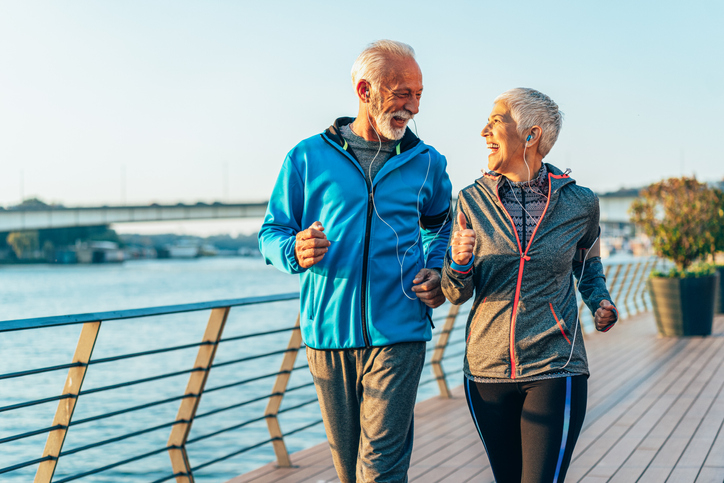Commitment + Clinical Leadership = Better Outcomes

How to Avoid Injuries When Exercising
Exercise is an important part of a healthy lifestyle because it can help you build strength, maintain weight, and prevent health problems. It’s been found that regular exercise can reduce your risk of diabetes, heart disease, high blood pressure, osteoporosis, and obesity.1
Whether you’ve been regularly exercising or are seeking to get started, here are 8 ways you can prevent injuries when exercising.
Ask a Personal Trainer Before You Start Exercising
If you are getting started with exercising, you should seek professional advice before you begin a training program. A personal trainer can let you know how much you should exercise and what kind of exercises you should begin with, as well as provide you with safety tips when getting started.
If you have a health condition, it is especially important that you consult with a medical expert before exercising. They can let you know what exercises are safe for your body and inform you of anything you shouldn’t do.
Warm-Up and Cool Down
Warming up before you exercise helps prepare your body for physical activity. Warm-ups will raise your body’s temperature and increase the blood flow to your muscles, which can help protect you from soreness and injuries.2
Cooling down after exercising can help your heart rate return back to its normal pace. According to the American Heart Association, one key part of cooling down is stretching because it can reduce lactic acid buildup. An excess of lactic acid in the body can cause soreness and muscle cramps.3
Learn Proper Techniques
When you begin a new workout routine, try to learn the proper form. Hiring a personal trainer or taking a class is a great way to begin a new workout routine and learn the correct way to physically perform different exercises.
Take it slow and don’t rush the learning process because improper technique can lead to injuries. Try to learn a few things at a time before incorporating a new set of exercises into your routine.
You should also familiarize yourself with any equipment you will be using to avoid accidents. There are user manuals that can tell you about different parts of exercise equipment, from the controls to safety precautions you should take before you get started.
Wear Proper Workout Clothes
Another way to avoid workout injuries is to wear the proper workout clothes for your sport. If you’re bicycling, you should wear the proper protective equipment to keep you safe in case of a fall. If you’re practicing yoga, clothes that are loose and allow you to stretch your body can help minimize pain and avoid potential injuries.
You should also make sure that you wear the correct shoes for your chosen activity. Some of the different types of shoes include running shoes, court sport shoes, field sport shoes, and track and field shoes, all of which help protect your feet when exercising. Your shoes should also be the right size, and you should replace your old shoes if they are worn out or have holes in them.
Stay Hydrated
It’s important to stay hydrated whenever you’re performing physical activity. Water helps regulate your body’s temperature as well as aiding in tissue and joint movement.
When you exercise, you will naturally feel thirsty if you don’t hydrate because your body will utilize the fluids it currently has. You will need to consistently replenish fluids to ensure your body can keep up with the heating-cooling process.
Dehydration causes your body to work harder, particularly your heart and kidneys. This can cause fatigue and dizziness, which can lead to injuries during physical activity. To avoid dehydration, make sure that you are drinking enough water when exercising.
Listen To Your Body
If your body becomes sore or a muscle begins to hurt, it is best to stop exercising and allow yourself to rest. Pain is a sign that you overexerted yourself and that your body needs to take a break.
Try to evaluate what may have caused the pain in the first place, as it could have been improper technique or overexerting yourself. If you continue to experience pain when exercising, consult with a medical expert.
Take Rest Days
It is recommended that you take a rest day every 3-5 days to allow your body to recover from physical activity. When you exercise, there are microscopic tears that are made in your muscles, and as you rest your cells will heal and grow.4
Over-exercising causes your body to produce hormones such as cortisol and adrenaline. This can affect your body’s sleep/wake cycle, blood sugar levels, metabolism, and salt-water balance.5
Start Slow and Increase Gradually
When starting a new exercise routine, you should start slow and gradually increase the duration in small increments. You want to get your body used to working out before you add more time, weights, or variations to your routine.
You may also find it helpful to break up your exercise session into different time blocks. For example, you might split a 30-minute workout into 15 minutes with a break in-between. This can help you reach your goals without overdoing it during an exercise session.
Saber Healthcare is an organization dedicated to providing consultant services to long term care providers. This article is for informational purposes and is not meant to be seen as professional advice. Please consult with a medical expert before relying on the information provided.
Sources
- https://familydoctor.org/why-exercise/#:~:text=Exercise%20is%20an%20important%20part,weight%20and%20curb%20your%20appetite.
- https://www.mayoclinic.org/healthy-lifestyle/fitness/in-depth/exercise/art-20045517#:~:text=Warming%20up%20helps%20prepare%20your,lessen%20your%20risk%20of%20injury.
- https://www.heart.org/en/healthy-living/fitness/fitness-basics/warm-up-cool-down
- https://www.healthline.com/health/exercise-fitness/rest-day
- https://www.webmd.com/fitness-exercise/what-to-know-rest-day-workouts
